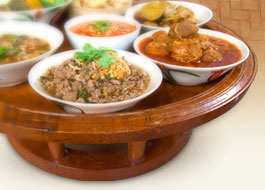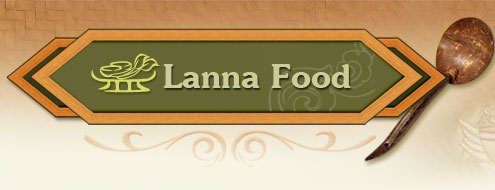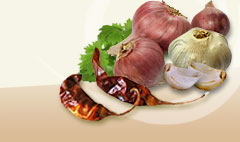Ming aralia |
|
|
 | Polyscias fruticosa |
|
| |
 | Araliaceae |
|
| |
 | Ming aralia |
|
| |
 | Khrut thot man, khrut bait het, lep khrut fai (Bangkok) (Kanchana Diwiset, et al., comp., 2005, p. 205) |
|
| |
 | There are many varieties of Lep Khrut, for example, khrut nok, khrut ngon kai, khrut bai ma tum whose scientific name is Polyscias balfouriana Bailey. Khrut i-pae or Polyscias filicifolia Bailey; khrut thot man, khrut phak chi whose scientific name is Polyscias fruticosa Harms; khrut bai yai and khrut yai whose scientific name is Polyscias guilfoylei Bailey; khrut thong kham whose scientific name is Polyscias pinnata Forst. (Wut Wuthithamwet, 1997, p. 401). It is a shrub, 2.5 m. high. The top part of the stalk is greenish brown with porous stems. Leaves simple compound of 3 levels, whirling around the stem like a winding staircase, length varies, leaflets are asymmetrical or varied, surrogated or dentate, heart shaped with clear veins. Inflorescence umbellate, central axis 60 cm. long with 30 cm. stems branching out, cluster of 12-20 flowers of 5 petals with 5 male and 1 male pistil. Fruit drupe-like, round, fleshy .5mm diameter. (Kanchana Diwiset, et al., comp., 2005, p. 205) |
|
| |
 |

No information available
Food: The young leaves and shoots are eaten raw with lap, lu, koi and dipped in flour batter for deep frying to be eaten with namphrik. (Kanchana Diwiset, et al., comp., 2005, 205)
|

All of the varieties have the same medicinal properties.
Leaves are spicy hot and pungent and are pulverized and placed on a wound to stop swelling and inflammation.
The whole plant: Bitter tasting, used to treat wounds and fever.
Roots fragrant and spicy hot, can be boiled and drunk to stimulate urination, calm nerves, reduce joint pain, and inhaled to stimulate sweating.
(Wut Wuthithamwet, 1997, p. 401; Kanchana Diwiset, et al., comp., 2005, p. 205)
|
|
| |
 | All year round |
|
| |
 |
Kanchana Diwiset, et al., comp. (2005). Phak Phuen Ban Phak Nuea. Phennapha Sapcharoen, ed. (2nd ed.). Nonthaburi: Center for Text Development of Traditional Thai Medicine. Wut Wuthithamwet. (1997). Saranukrom Samunphrai: Ruam Lak Phesatchakam Thai. Bangkok: Odeon Store. |
|
| |
|
|




